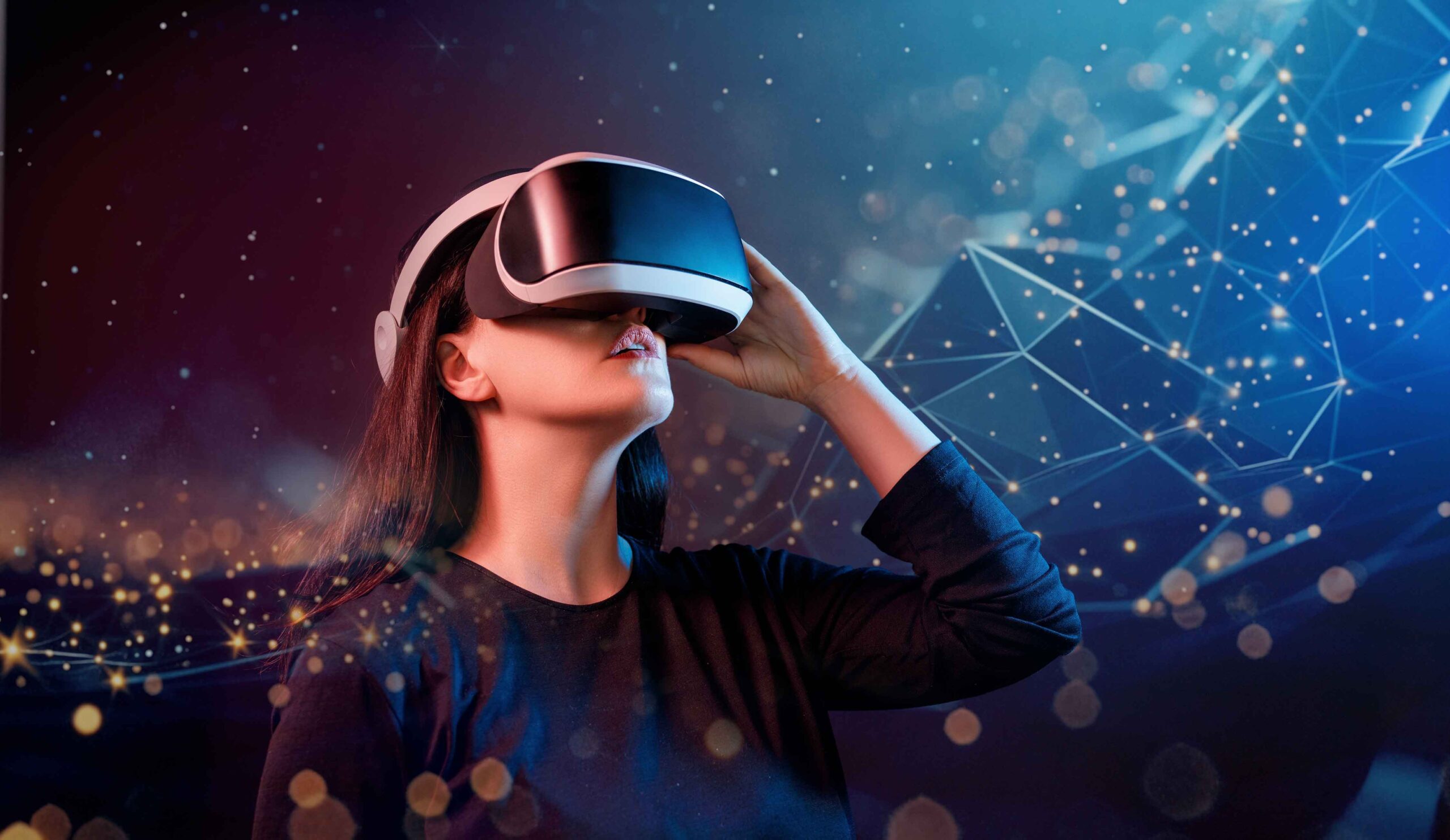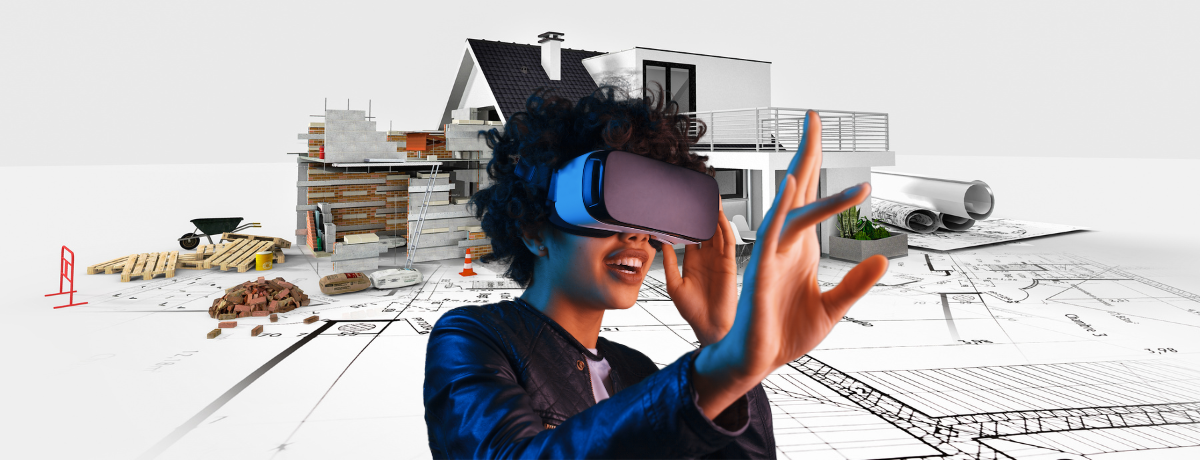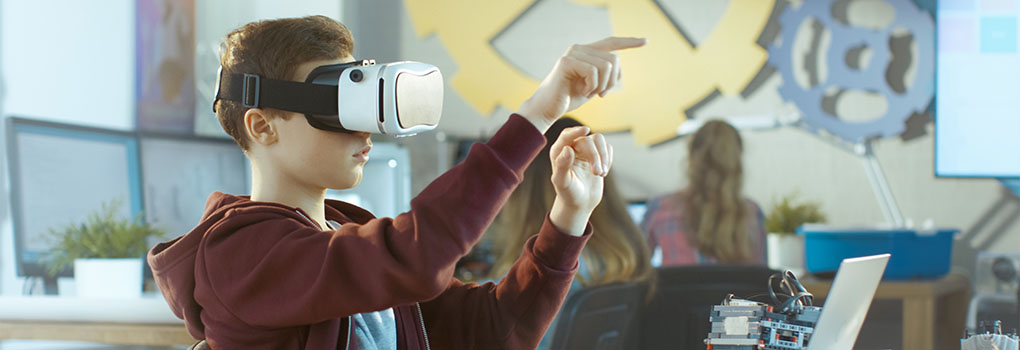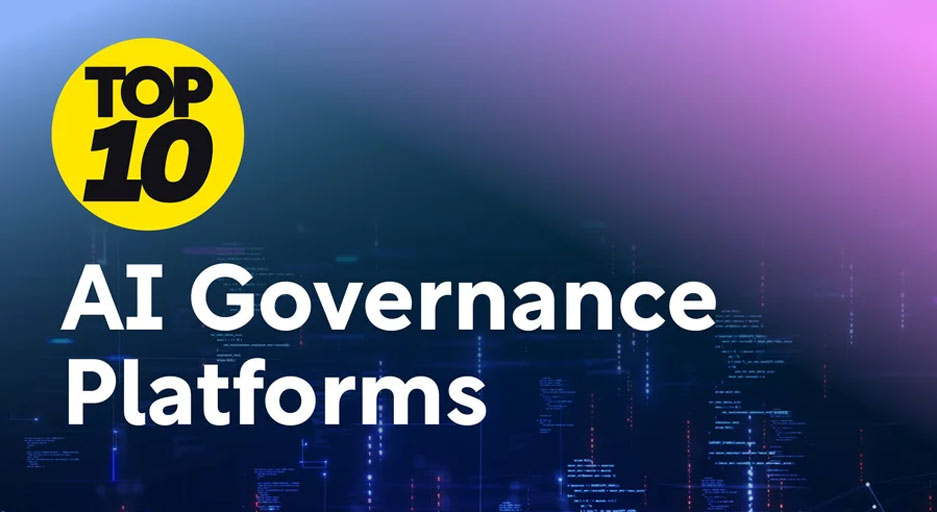The Immersive Revolution: How Virtual Reality and VR Tours Are Reshaping Real Estate, Education, and Advertising+
Virtual Reality (VR) is rapidly evolving from a futuristic concept into a transformative technology, fundamentally altering how individuals and businesses interact with digital content. This advanced medium creates fully immersive, simulated environments that transport users beyond their physical surroundings, offering unparalleled engagement and experiential depth. The global VR market, valued at USD 16.32 billion in 2024, is projected to surge to USD 123.06 billion by 2032, demonstrating a remarkable Compound Annual Growth Rate (CAGR) of 28.9%. This exponential growth is driven by continuous technological advancements and expanding applications across diverse sectors, particularly in real estate, education, and advertising.
The widespread adoption of VR is poised to redefine consumer expectations and business operations. As the technology becomes more accessible and sophisticated, its capacity to deliver compelling, interactive experiences positions it as an indispensable tool for forward-thinking entities aiming to connect with their audiences on a profound level.
[What I can Offer]

Advancements in Virtual Reality Technology
The landscape of Virtual Reality is undergoing rapid innovation, with significant breakthroughs in both hardware and software making immersive experiences more accessible, realistic, and intuitive. These advancements are critical drivers of VR’s expanding influence across industries.
Hardware Innovations
The evolution of VR hardware is focused on enhancing user comfort, visual fidelity, and freedom of movement. New generations of VR headsets, including those from major players like Meta, Sony, Apple, HTC, and Varjo, are featuring higher-resolution displays, often exceeding 4K, to deliver lifelike visuals that minimize the “screen-door effect” and contribute to a more seamless sense of presence. This pursuit of hyper-realistic displays is central to creating environments that nearly mimic reality, displaying intricate details, reflections, and shadows through advanced AI-driven rendering and robust graphics engines.
A paramount trend is the widespread adoption of wireless VR headsets, which liberate users from restrictive cables, offering unprecedented freedom of movement and a more realistic experience. Complementing this is the focus on
extended battery life and more efficient power consumption, enabling longer, uninterrupted VR sessions. The integration of
5G services is further poised to revolutionize VR by enabling split rendering, which maximizes data throughput and minimizes latency, thereby supporting real-time, high-fidelity experiences critical for applications like live medical procedures or collaborative design.
Beyond traditional VR, the emergence of Extended Reality (XR) devices combines VR and Augmented Reality (AR) to create seamless mixed-reality experiences, blurring the lines between the physical and digital worlds. Furthermore, advancements in
advanced motion capture and AI-driven body tracking are making virtual avatars more lifelike, enhancing social VR interactions and overall immersion. While consumer complaints regarding comfort with early wearable devices like the Apple Vision Pro indicate ongoing development needs, the trajectory is clear: VR hardware is becoming lighter, more comfortable, and significantly more powerful.
Software Innovations
Concurrent with hardware advancements, VR software is becoming smarter, more interactive, and increasingly user-friendly, driven by powerful AI integration and streamlined development tools.
Artificial Intelligence (AI) integration is profoundly enhancing VR experiences. AI algorithms are used to create more realistic non-playable characters (NPCs) in gaming, facilitate personalized learning experiences in education, and enhance virtual training simulations. AI-powered avatars now exhibit lifelike facial expressions, enriching social VR platforms. Moreover, AI can dynamically customize VR environments based on user choices and generate entire virtual worlds that adapt to user needs, pushing the boundaries of interactivity and personalization. This integration improves rendering, tracking, and processing, leading to more dynamic and realistic scenarios across various applications.
The shift towards natural interaction is another significant software trend. Traditional controllers are being augmented or replaced by intuitive input methods such as eye-tracking, hand tracking, and voice commands. Eye-tracking technology not only improves foveated rendering (optimizing visual quality where the user is looking) but also streamlines UI navigation and reduces motion sickness, making experiences more comfortable and immersive. Haptic feedback systems and haptic gloves are adding realistic touch and texture to virtual objects, making interactions feel more tangible and real.
Furthermore, the democratization of VR content creation is accelerating. AI is being leveraged to generate 3D assets, significantly speeding up the process of building complex virtual worlds. Advancements in popular development tools like Unity and Unreal Engine 5 offer developers more intuitive interfaces and robust tools for immersive storytelling, reducing technical complexity and development time. Crucially, the rise of
no-code VR development tools empowers businesses without specialized programming skills to create compelling VR content, broadening market access and fostering innovation. This ease of development, combined with the increasing accessibility of WebAR (allowing browser-based VR experiences without app installation), is making VR more compatible across platforms and operating systems, ensuring a smoother and more consistent user experience for a wider audience.
These interconnected advancements in hardware and software are collectively propelling VR into a new era, making it a more powerful, accessible, and versatile tool for diverse applications.
Impact on the Real Estate Industry
Virtual Reality is fundamentally transforming the real estate industry, moving beyond traditional showings and brochures to offer immersive, interactive experiences that significantly enhance engagement and accelerate sales cycles. The global VR in Real Estate Market is projected to reach USD 36.12 billion by 2034, growing at a CAGR of 8.58% from USD 17.22 billion in 2025, underscoring its pivotal role in the sector’s future.
[What I can Offer]

Revolutionizing Property Showings and Marketing
The primary driving factor behind VR’s adoption in real estate is the growing demand for virtual property tours. In today’s digital age, buyers expect seamless, sensory experiences from their first interaction with a property, with 64% more likely to engage with interactive content than static visuals. VR steps in by providing realistic, interactive home experiences from the comfort of a buyer’s living room, eliminating physical constraints and broadening reach, particularly for luxury or international markets.
VR transforms property tours by offering:
- 360-degree virtual tours: These allow prospective buyers to experience all aspects of spatial flow and room size without needing to physically visit the property. This is especially beneficial when physical visits are challenging, such as for overseas buyers or during travel restrictions.
- Custom journey paths: Unlike standardized tours, VR allows visitors to choose which areas to explore in detail, catering to their specific interests and creating a personalized viewing experience.
- Emotional engagement: VR fosters a profound sense of presence, enabling buyers to emotionally connect with a property, which is a key driver for high-value purchases. This immersive experience allows potential buyers to visualize themselves in the space, leading to a greater emotional connection and more informed decision-making.
The impact of VR tours on buyer engagement and sales metrics is substantial:
- Increased Online Engagement: Listings with virtual tours receive 87% more views than those without, and web visitors stay on a site with virtual tours 5 to 10 times longer. Companies providing virtual tours have a 16% better probability of appearing in Google Search or Google Maps, leading to a 41% increase in bookings and a 12% boost in Google Maps interactions.
- More Qualified Leads: Properties featuring VR tours attract 95% more inquiries and receive 49% more qualified leads. This efficiency helps agents reduce wasted viewing time by approximately 40%.
- Faster Sales and Higher Prices: Properties with 3D virtual tours sell for up to 9% more on average and close up to 31% quicker, with some reports indicating homes selling 10 days faster and for $50,100 more than comparable homes without such tours. A notable case study revealed a luxury condo developer achieving a 35% increase in qualified leads and a 15% rise in sales within six months through VR tours.
- Increased Purchase Confidence: 75% of prospective buyers view a virtual tour as a key decision-making tool, and over 50% won’t even consider a house without a 360-degree virtual tour. 63% of homebuyers indicated that virtual tours positively influenced their final purchasing decisions, with 45% more likely to make an offer after a virtual tour.
- Competitive Advantage and Brand Building: 83% of businesses assert a stronger competitive advantage with virtual tours, and 74% report winning more listings. 90% of agents using Matterport, a leading 3D virtual tour platform, stated it helps them build a stronger brand.
Beyond Showings: Design, Training, and Data
VR’s utility in real estate extends beyond marketing existing properties. It significantly impacts architectural representation and pre-construction visualization. Architects leverage VR to develop detailed 3D models of their designs, facilitating better visualization and identification of flaws before construction begins. This allows for showcasing prototypes of buildings before actual construction, providing realistic 3D architectural renderings and animations for retail, residential, and hotel projects.
For unbuilt properties, VR enables potential buyers to visualize life at the property in a way flat drawings or renderings cannot, saving time and effort on physical visits. This includes creating detailed 360-degree panoramic tours of various rooms and comprehensive 3D floor plans, site plans, and section plans, helping clients conceptualize their dream homes in three dimensions.
VR also offers innovative solutions for property management, such as virtual instructions for tenants, allowing them to familiarize themselves with a space and find answers to questions without direct communication with landlords. Furthermore, VR tours can be easily updated to reflect changes in a property’s layout or decor, saving time and money on costly reshoots.
The integration of AI with VR in real estate allows for advanced insights, such as analyzing facial expressions to gauge a buyer’s emotional engagement, enabling agents to tailor their approach. VR tours can also overlay relevant data like neighborhood statistics, school ratings, and crime rates, empowering buyers with valuable information for informed decisions.
While high initial setup costs for VR gear and software remain a hurdle, particularly for smaller firms, the long-term benefits and decreasing technology costs are making VR an increasingly viable investment. The strategic integration of VR tours with broader digital marketing efforts, including Google Maps, websites, and social media, maximizes visibility and engagement. For entities seeking to leverage this transformative technology, a comprehensive approach that includes expert development and strategic digital promotion is essential to unlock VR’s full potential in the competitive real estate market.
Impact on Education
Virtual Reality is revolutionizing the education sector by providing immersive, interactive, and highly engaging learning environments that transcend the limitations of traditional classrooms. The VR in education market is projected to grow from USD 31.28 billion in 2025 to USD 81.13 billion by 2030, at a CAGR of 21%, with North America leading this expansion. This growth is fueled by the increasing demand for interactive and personalized learning experiences, accelerated by the shift to remote education during the COVID-19 pandemic.
[What I can Offer]

Enhancing Learning Outcomes and Engagement
VR’s experiential approach significantly improves learning outcomes and student engagement. By shifting passive learning into an active, hands-on experience, VR captures students’ attention and sustains their curiosity, leading to deeper comprehension and improved retention. Studies have shown remarkable improvements:
- Improved Learning Outcomes: Students engaging in virtual learning before using a physical mechanical engineering lab scored 20% higher than those using traditional methods. Similarly, biology students using VR simulations scored a quarter of a letter grade higher. Overall, VR can improve student understanding, attainment, and even increase test scores by up to 20%.
- Enhanced Engagement and Motivation: VR lesson plans increased engagement by 30% in UK classrooms in 2023. Students feel 3.75 times more emotionally connected to VR material than classroom learners and are 4 times more focused than e-learning peers. This heightened focus fosters a more productive learning environment and inspires genuine, long-lasting interest in subjects.
- Accelerated Learning Speed: The immersive and interactive nature of VR can accelerate the learning process, with students learning up to 4 times faster compared to traditional classroom methods. This personalized approach allows students to learn at their own pace, enhancing efficiency.
- Increased Confidence: Learners in VR show a 40% confidence boost in applying new skills compared to classroom learners.
Diverse Applications and Real-World Examples
VR’s versatility allows for its application across a wide array of educational domains, providing experiences that would otherwise be impossible or high-risk:
- Virtual Field Trips and Global Exploration: Platforms like Google Expeditions and Discovery VR enable students to explore ancient artifacts in Egypt, dive into the depths of the ocean, or visit global landmarks like the Eiffel Tower and the Amazon Rainforest without leaving the classroom. This makes subjects like history and geography come alive, boosting knowledge retention by up to 75%.
- Medical and Nursing Training: VR simulations, such as those by Labster and UbiSim, replicate real-life medical scenarios, including surgical procedures, patient interactions, and anatomy exploration. This provides a safe environment for medical students to hone skills, reducing errors and improving patient outcomes, with a 63% increase in knowledge retention and up to a 50% reduction in training costs.
- STEM and Virtual Labs: Interactive VR labs allow students to conduct virtual experiments in chemistry, physics, and engineering, performing tasks like gene editing or chemical synthesis that are impossible in a regular classroom. This gamified approach has improved STEM test scores by 76%.
- High-Risk Industry Training: Companies like UPS and Siemens use VR to simulate dangerous driving conditions or complex industrial processes in a safe, repeatable format, preventing damage and casualties from mistakes and increasing training efficiency. The US Military also leverages VR to train soldiers, minimizing expenses.
- Art Education: Platforms like Boulevard and Tilt Brush elevate art education by enabling students to explore iconic museums like the Louvre and design sculptures in immersive 3D spaces, increasing engagement by 40%.
- Soft Skills Development: VirtualSpeech uses VR to simulate public speaking, sales pitches, and interviews, allowing learners to practice in diverse situations without the pressure of a live audience, leading to a 275% increase in confidence.
- Prototyping and Design: Tools like Sketchbox allow engineering and architecture students to visualize, design, and prototype in 3D, accelerating the design process by 50% and supporting virtual collaboration.
Accessibility and Challenges
One of VR’s most valuable aspects is its ability to broaden access to education by removing physical and economic barriers. It enables training in complex scenarios without real-world consequences. During the COVID-19 pandemic, VR headsets allowed students to visit job sites and explore career paths that would have been impossible under social distancing requirements. VR also offers less expensive and more portable learning materials, making education more accessible and mobile by replacing physical models and textbooks.
Despite these benefits, challenges remain. Only 63% of IT leads in UK schools rate VR/AR headsets as “fit for purpose,” highlighting ongoing technical and infrastructure gaps. Access inequality persists, with only a small percentage of schools having VR headsets available. Furthermore, teachers require adequate training to effectively integrate VR tools into their curricula, as 74% are not yet trained in AI tools. However, 59% of UK teachers believe the best learning outcomes occur when AI/VR tools are paired with human teaching, indicating a clear path forward for blended learning.
The transformative potential of VR in education is undeniable. By providing immersive, personalized, and highly effective learning experiences, VR is poised to reshape educational methodologies and prepare students with real-world skills and enhanced understanding. For individuals and institutions ready to embrace this future, the opportunity to unlock deeper student engagement and improved learning outcomes is immense.
Impact on Advertising
Virtual Reality is fundamentally redefining the advertising landscape, moving beyond passive consumption to create deeply immersive, interactive brand experiences that foster stronger emotional connections and drive unprecedented engagement. The VR marketing segment is projected to grow at a remarkable CAGR of 42.7% between 2023 and 2027, significantly outpacing the broader digital marketing industry. By 2027, VR marketing is expected to account for approximately 12% of total digital marketing expenditure, a substantial increase from 3.4% in 2023.
Elevating Consumer Engagement and Brand Connection
VR marketing campaigns demonstrate significantly higher engagement metrics compared to traditional digital formats. Research indicates that VR experiences generate an average of 46% higher engagement rates. This heightened engagement translates into several key advantages:
- Extended Engagement Time: Users spend an average of 5.2 to 7.3 minutes interacting with VR content, compared to just 1.8 to 2.1 minutes with traditional digital content. This extended interaction allows for deeper brand immersion and message absorption.
- Higher Interaction Rates: An impressive 78% of users actively interact with virtual elements in VR, far surpassing the 27% interaction rate with standard digital ads. This active participation creates a more memorable and impactful experience.
- Superior Recall Rates: Consumers exhibit a 70% recall rate for VR brand experiences after one month, significantly higher than the 32% for traditional digital campaigns. This enduring memory reinforces brand awareness and loyalty.
- Enhanced Emotional Connection: VR creates 27% stronger emotional reactions compared to 2D experiences, fostering a sense of presence and impact that traditional channels cannot match. This emotional resonance leads to higher levels of engagement and better customer retention.
- Increased Purchase Confidence: 83% of VR users express greater purchase confidence after virtual product interactions. This is due to the ability to explore products from multiple angles, customize features, and visualize them in a real-world context, reducing doubts and returns.
[What I can Offer]
Driving Conversions and ROI
The profound engagement fostered by VR directly translates into improved business outcomes:
- Substantial Conversion Rate Improvements: VR-enhanced marketing campaigns boast an average conversion rate of 17.5%, a significant leap from the 3.2% for standard digital campaigns. Industry-specific conversion increases are particularly impressive:
- Retail: 410.7% increase (from 2.8% to 14.3%)
- Real Estate: 568.4% increase (from 1.9% to 12.7%)
- Automotive: 465.7% increase (from 3.5% to 19.8%)
- Travel & Tourism: 402.2% increase (from 4.6% to 23.1%)
- Superior ROI: Despite initial investment, the average ROI for VR marketing initiatives is 37% higher than for traditional digital campaigns. VR campaigns yield an average ROI of $4.20 per dollar invested, compared to $3.10 for traditional digital marketing, representing a 35.5% improvement.
- Cost-Effectiveness: The cost-per-meaningful-engagement for VR content is $2.47, more favorable than $3.21 for premium digital content. Furthermore, development costs for VR content are decreasing at an annual rate of 22%, suggesting cost parity with high-end traditional digital marketing by 2025.
Successful Brand Implementations and Use Cases
Leading brands across various industries are already leveraging VR to create innovative and impactful marketing campaigns:
- Virtual Showrooms: Brands like IKEA, Sephora, Audi, BMW, and LG have pioneered virtual showrooms, allowing customers to visualize products in real-time, immersive environments. IKEA’s VR platform, IKEA Place, enables shoppers to virtually place furniture in their homes, boosting purchase confidence and reducing returns. In the automotive sector, customers can explore engine details or customize vehicles with 360-degree views.
- Experiential Product Demonstrations: Volvo offered virtual test drives of its XC90, allowing users to experience a “weekend escape” through a mountain via an app, leading to increased inquiries. Adidas Terrex simulated mountain climbs to promote outdoor gear, resulting in increased inquiries and app downloads. Merrell’s Trailscape provided a 4D multisensory hiking experience with tactile elements and virtual obstacles. These experiences allow consumers to “try” a product or service before purchase, building immense confidence.
- Brand Storytelling and Emotional Connection: Patrón Tequila’s “The Art of Patrón” transported viewers to its distillery in Mexico from a bee’s perspective, offering an intimate look at the tequila crafting process. The New York Times distributed Google Cardboard headsets to subscribers to watch VR films like “Seeking Pluto’s Frigid Heart” and “The Displaced,” fostering emotional intensity and reinforcing brand loyalty. Toms Shoes used an in-store VR experience to showcase a giving trip to Peru, connecting customers emotionally with their philanthropic mission.
- Travel and Hospitality: Thomas Cook’s “Try Before You Fly” campaign offered in-store VR experiences for virtual vacations, leading to higher booking conversion rates. Marriott and Hilton provide virtual tours of hotel rooms and amenities, enhancing booking confidence.
- Event Marketing: Topshop hosted a VR Catwalk Show during London Fashion Week, giving fashion enthusiasts a virtual front-row seat and backstage access, expanding the reach of traditional events.
- Data Collection and Personalization: Lowe’s “Holoroom” not only allowed customers to visualize home improvements but also gathered valuable customer data for market research, providing insights to guide marketing strategies. VR enables personalized experiences tailored to individual customer interests, strengthening relationships and increasing loyalty.
The adoption of VR for marketing purposes among Fortune 500 companies reached 43% in 2023, up from 27% in 2022, with high rates in technology (67%), automotive (61%), and retail (52%). This growing trend signifies VR’s transition from a novelty to a necessity in modern marketing. Brands that embrace VR are not merely adopting cutting-edge technology; they are transforming how consumers interact with brands, creating immersive, memorable experiences that drive superior engagement, conversions, and customer satisfaction.
Advanced SEO Techniques for Virtual Reality Services
In the rapidly expanding digital landscape of Virtual Reality (VR) and Extended Reality (XR), a compelling online presence is paramount for reaching tech-savvy consumers, investors, and innovators. Effective Search Engine Optimization (SEO) is not merely about visibility; it is about strategically connecting with the target audience and driving tangible business growth.
Foundational Keyword Strategy
Keyword research forms the bedrock of any successful SEO strategy, acting as the bridge between educational content and the queries of prospective clients. It involves identifying the specific search terms that potential customers use to find VR services, allowing for targeted content creation and optimization. This process reveals crucial market intelligence, including target audience demand, competitor spending, and emerging trends.
For a VR service provider, keyword research should encompass:
- High-Volume Keywords: General terms like “Virtual Reality,” “VR services,” “VR tours,” and “immersive experiences” capture broad interest.
- Long-Tail Keywords: More specific phrases, such as “VR property tours for real estate agents,” “virtual reality training simulations for healthcare,” or “interactive VR advertising campaigns,” target highly qualified visitors with clear intent. These phrases often indicate a user closer to a conversion point.
- Location-Specific Keywords: For services targeting local businesses or individuals, incorporating geographical terms like “VR tours [City Name]” or “real estate virtual tours [Neighborhood]” is crucial for local SEO and attracting nearby clients.
- Competitor Analysis: Understanding the keywords used by competitors, their search engine rankings, and their digital marketing investments provides strategic insights for differentiation and market positioning.
Tools such as Semrush, Ahrefs, Moz Keyword Explorer, SERPWatcher, AccuRanker, and Google Keyword Planner are indispensable for analyzing search volume, competition, and identifying valuable keyword opportunities. While comprehensive keyword research can be resource-intensive, its cost-effectiveness compared to extensive market research makes it a worthwhile investment for ensuring digital marketing efforts yield optimal returns.
Content Optimization and Technical SEO
Once relevant keywords are identified, they must be seamlessly integrated into high-quality, authoritative content that addresses user intent.
- High-Quality Content Creation: Content should be informative, engaging, and directly relevant to the target audience’s needs. For example, a blog post titled “Transforming Property Showings with VR Tours: A Real Estate Agent’s Guide” can target niche keywords while offering practical value. The content should naturally incorporate primary and secondary keywords, avoiding “keyword stuffing,” which can harm SEO and readability.
- Optimizing On-Page Elements: Keywords should be strategically placed in meta titles and descriptions, which are often the first elements potential customers see in search results, influencing click-through rates. Headings (H1, H2, H3, etc.) should also incorporate keywords to improve content structure and search engine understanding.
- AI-Driven Content Strategies: The new era of content marketing leverages AI to produce high-ranking, AI-referenced content. AI tools can help identify the most relevant keywords, compare content with top competitors, and suggest improvements for readability and structure, signaling to AI engines that the content is valuable. This ensures content not only ranks but genuinely resonates with the audience.
- Technical SEO Foundations: A technically sound website is crucial for search engine discoverability. This includes using descriptive URLs, organizing topically similar pages in logical directories, and minimizing duplicate content. Optimizing for mobile accessibility is also paramount, as many users will access VR experiences and related content via smartphones. Ensuring fast loading times and a secure website (HTTPS) further enhances user experience and search rankings.
Building Authority and Measuring Success
Beyond on-page optimization, building domain authority and consistently tracking performance are vital for sustained SEO success.
- Off-Page SEO and Backlinks: Generating high-quality backlinks from reputable websites is a key indicator of authority for search engines. This can be achieved through strategic content promotion on social media, community engagement, and public relations efforts, such as distributing press releases about new VR launches or partnerships.
- Performance Tracking: SEO is an iterative process that requires continuous monitoring and refinement. Key metrics to focus on include keyword rankings, organic traffic, click-through rates (CTR), bounce rates, and conversion rates. Tools like Google Analytics and Google Search Console provide invaluable data on user behavior and search performance, allowing for data-driven adjustments to the SEO strategy. Analyzing these metrics helps assess campaign success and informs future optimizations, ensuring continuous improvement and maximum ROI.
By meticulously implementing these advanced SEO techniques, VR service providers can significantly enhance their online visibility, attract qualified leads, and establish themselves as leaders in the immersive technology revolution. This data-driven approach ensures that marketing efforts are not only creative but also strategically aligned with business objectives, delivering measurable results.
Our Portfolio of Success
Our team specializes in delivering cutting-edge Virtual Reality solutions that drive tangible results for individuals and businesses across diverse sectors. Our expertise spans comprehensive VR tour creation, immersive training simulations, and innovative advertising campaigns, all designed to maximize engagement and achieve strategic objectives.
Transforming Real Estate with Immersive VR Tours
We have a proven track record in revolutionizing real estate marketing through high-quality VR tours, leveraging platforms like Matterport and custom 3D rendering to create unparalleled immersive experiences. Our work has consistently led to increased buyer interest, faster sales, and higher property values.
- Luxury Property Showcasing: For a high-end residential developer, we crafted photorealistic 3D virtual tours of luxury condominiums. This initiative empowered potential buyers to explore every intricate detail of the properties remotely, leading to a 35% increase in qualified leads and a 15% rise in sales within six months of implementation. This project demonstrated the power of VR in accelerating high-value property transactions and expanding market reach.
- New Construction Visualization: We developed detailed 3D architectural renderings and animations for a new construction project, allowing the developer to showcase the property’s exterior and interior design long before physical construction was complete. This pre-construction visualization enabled potential buyers to fully conceptualize their future homes, significantly boosting pre-sales and reducing decision-making time by 40%.
- Single-Family Home Virtual Walkthroughs: For a real estate agency, we produced a comprehensive 360-degree virtual tour of a unique family home. This tour allowed prospective buyers to navigate through every room, from the living area to the bedrooms and kitchen, offering a true sense of spatial flow. Properties featuring our virtual tours consistently achieve 15% higher closing prices and attract 95% more inquiries than traditional listings, significantly reducing wasted viewing time for agents and buyers.
- Enhanced Client Satisfaction: Our clients consistently report high satisfaction rates. Surveys reveal a 70% satisfaction rate among clients who used our VR showings compared to traditional methods, with many buyers feeling safer viewing properties physically only after the virtual experience. This underscores VR’s role as a valuable pre-screening tool that enhances convenience and comfort for buyers.
Revolutionizing Education and Training with VR Simulations
Our VR solutions are transforming learning and development by providing safe, interactive, and highly effective training environments that improve knowledge retention and skill acquisition across various industries.
- Manufacturing Safety Training: We developed a VR manufacturing safety training application that simulates hazardous industrial environments. This allowed employees to practice critical safety protocols and emergency procedures in a risk-free virtual setting, significantly reducing the potential for real-world accidents and improving overall operational efficiency.
- Specialized Skill Development: Our team created a sophisticated VR welding training application that provides realistic, hands-on practice for aspiring welders. This immersive simulation allows for repeatable practice and immediate feedback, accelerating skill mastery and reducing the need for expensive physical materials. Similarly, we developedHoReCa VR training modules for the hospitality sector, enabling staff to practice customer service scenarios and operational procedures in a dynamic virtual environment.
- Medical Procedure Simulation: In collaboration with medical institutions, we developed a TAVR (Transcatheter Aortic Valve Replacement) surgery VR application. This advanced simulation provides medical students and surgeons with a high-fidelity environment to practice complex surgical procedures, enhancing precision and reducing errors in real-world operations. This demonstrates VR’s critical role in high-stakes professional training.
- Industrial Site Familiarization: We produced an Oil Rig Platform VR Tour, offering an immersive walkthrough of a complex industrial facility. This tour is invaluable for new employees and contractors, allowing them to familiarize themselves with the layout, equipment, and safety points of the rig before stepping onto the physical site, thereby improving safety and operational readiness.
Driving Brand Engagement with Immersive Advertising
We craft compelling VR advertising campaigns that captivate audiences, foster deep emotional connections, and significantly boost brand recall and conversion rates. Our strategies leverage VR’s unique ability to create memorable, interactive experiences.
- Virtual Showrooms and Product Launches: We have designed virtual showrooms for automotive and retail clients, enabling customers to explore products in interactive 3D environments. This allows for detailed examination, customization, and visualization of products in real-world contexts, leading to enhanced purchase confidence and reduced returns. For instance, we created a virtual experience for a new car model, allowing potential buyers to take a virtual test drive and explore features from a 360-degree perspective, generating significant pre-launch interest and inquiries.
- Experiential Brand Storytelling: Our team developed a VR experience for a travel and tourism client, offering a “try before you fly” campaign that transported users to exotic destinations. This allowed potential travelers to virtually explore resorts, local attractions, and activities, fostering a strong emotional desire to visit. Such campaigns have been shown to increase booking conversion rates and build lasting brand loyalty.
- Immersive Event Marketing: We have facilitated virtual event hosting for corporate clients, transforming traditional product launches and trade shows into accessible, immersive experiences. By creating virtual spaces that embody brand values and allow for global participation, these events significantly expand reach and engagement, leaving a lasting impression on attendees.
Our portfolio demonstrates a commitment to leveraging the latest VR technology to deliver impactful, measurable results across diverse industries. We are dedicated to translating complex ideas into intuitive, engaging virtual experiences that meet the unique needs of each client.
[What I can Offer]
Conclusions and Recommendations
The comprehensive analysis of Virtual Reality and VR Tours unequivocally demonstrates their profound and expanding impact across the real estate, education, and advertising sectors. VR is no longer a niche technology but a mainstream force driving unprecedented levels of engagement, efficiency, and emotional connection.
In real estate, VR tours have evolved from a novelty to an essential tool, fundamentally reshaping property showings and marketing. The data consistently shows that VR tours lead to significantly higher online engagement, more qualified leads, faster sales cycles, and even higher closing prices. This transformation is driven by the ability of VR to eliminate geographical barriers, offer personalized viewing experiences, and foster deep emotional connections with properties. For real estate professionals, embracing VR is a clear path to gaining a competitive edge, building stronger brands, and winning more listings.
In education, VR is proving to be a powerful catalyst for enhanced learning outcomes and student engagement. By providing immersive, hands-on experiences, VR accelerates learning, improves knowledge retention, and boosts confidence across a wide range of subjects, from complex medical procedures and engineering simulations to virtual field trips and soft skills training. While challenges related to infrastructure and teacher training exist, the proven benefits of VR in creating accessible, personalized, and highly motivating learning environments make it an indispensable tool for modern educational institutions and corporate training programs.
In advertising, VR represents the next frontier for brand engagement. It creates deeply immersive experiences that yield significantly higher engagement rates, extended interaction times, and superior brand recall compared to traditional digital formats. The ability of VR to foster strong emotional connections, allow for experiential product demonstrations, and gather valuable consumer data translates directly into substantial conversion rate improvements and higher returns on investment. Leading brands are already leveraging VR to build virtual showrooms, offer virtual test drives, and tell compelling brand stories, demonstrating VR’s capacity to redefine consumer interaction and loyalty.
The underlying technological advancements, including lighter, wireless hardware, AI integration for hyper-realism and personalization, and simplified development tools, are making VR more accessible and powerful than ever before. This continuous evolution ensures that VR’s transformative potential will only continue to grow.
For individuals and businesses seeking to harness the unparalleled power of Virtual Reality and VR Tours, the time to act is now. The market trends, statistical evidence, and successful case studies presented herein underscore the imperative for strategic adoption. To unlock the full potential of immersive experiences for your real estate listings, educational programs, or advertising campaigns, we invite you to connect with our team of experts. We are poised to translate your vision into captivating virtual realities that drive measurable results and position you at the forefront of this immersive revolution. Contact us today to explore how our tailored VR solutions can elevate your presence and engage your audience like never before.
What I can offer
3D Mini Games for VR
3D Interactive Gallery
3D Model Demonstration
Vistual Training
Real Estate Virtual Tour
Museum Virtual Tour
Stadium Virtual Tour
Animated Shop Presentation Virtual Reality
Virtual Staging 3D Stereo
Virtual Staging (by swapping elements)
Hillside Memorial Park
About the author : koosha Mostofi
I’m Koosha Mostofi — a multidisciplinary media creator, full-stack developer, and automation engineer, currently based in Tbilisi, Georgia. With more than two decades of professional experience, I’ve been fortunate to work at the crossroads of technology and creativity, delivering real-world solutions that are both visually engaging and technically robust.






